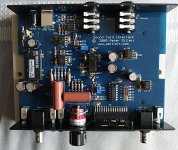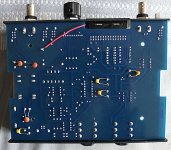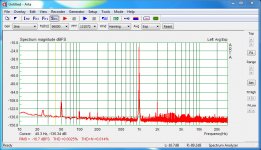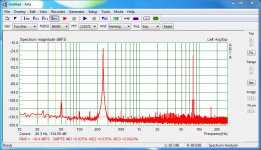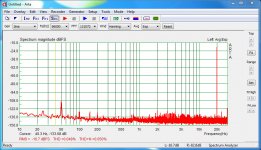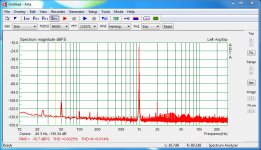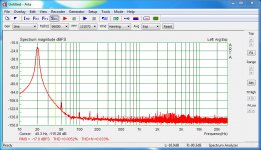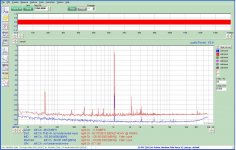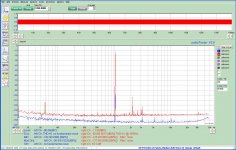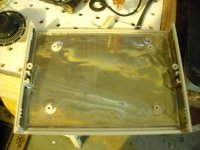Hi Linksguru
Could you post an picture of the inside of your box?
Andrew
Hi, AndrewL,
Here are the pictures of assembled PCB.
Additionally, as many forum members suggested, I grounded shaft of rotary switch, 50 Hz noise went down by -4dB. Closest ground point is R11 (see red wire on photo).
Test in loopback mode (input and output connected together on 33K resistor terminals), 1.9V sound card out, 96KHz, attached.
Attachments
Last edited:
I would like to add a not to ESI Juli users. Although sound card itself is very good, its seems it works better (in this particular application) in 96KHz, not 192 KHz mode. I don't know why, I suspect high-frequency noise picked up by SCI.
So next step will be to building foil shield inside plastic box.
At a glance, precision looks very good (0.0025% THD, 0.014% THD + N @ 1.9V/1KHz), but it is actually not so. Due to the noise (or some other reasons), it is not possible to precisely measure THD at small signal level, e.g. 20mV, and precision at 20 KHz limited to 0.05%.
I'm attaching tests in loopback mode, 20Hz - 1KHz - 20KHz, 1.9V output from ESI Juli (balanced connection), 96KHz sampling rate.
So next step will be to building foil shield inside plastic box.
At a glance, precision looks very good (0.0025% THD, 0.014% THD + N @ 1.9V/1KHz), but it is actually not so. Due to the noise (or some other reasons), it is not possible to precisely measure THD at small signal level, e.g. 20mV, and precision at 20 KHz limited to 0.05%.
I'm attaching tests in loopback mode, 20Hz - 1KHz - 20KHz, 1.9V output from ESI Juli (balanced connection), 96KHz sampling rate.
Attachments
I would like to add a not to ESI Juli users. Although sound card itself is very good, its seems it works better (in this particular application) in 96KHz, not 192 KHz mode. I don't know why, I suspect high-frequency noise picked up by SCI.
So next step will be to building foil shield inside plastic box.
At a glance, precision looks very good (0.0025% THD, 0.014% THD + N @ 1.9V/1KHz), but it is actually not so. Due to the noise (or some other reasons), it is not possible to precisely measure THD at small signal level, e.g. 20mV, and precision at 20 KHz limited to 0.05%.
I'm attaching tests in loopback mode, 20Hz - 1KHz - 20KHz, 1.9V output from ESI Juli (balanced connection), 96KHz sampling rate.
At 96khz you should be able to measure out to about 45khz. At 192khz, out to about 90khz. There is a setting in Arta that will allow you to expand you window to view these higher frequencies.
Second, learn to used the averages function for fft. It will smooth your response lines. I would Start with 25 averages.
Ken
At 96khz you should be able to measure out to about 45khz. At 192khz, out to about 90khz. There is a setting in Arta that will allow you to expand you window to view these higher frequencies.
Second, learn to used the averages function for fft. It will smooth your response lines. I would Start with 25 averages.
I know about expanding graph ranges/window - if you look at my attachment, they display charts in 10Hz - 30KHz ranges instead of standard 20Hz-20KHz.
Averaging turned on - it is clearly visible on top menu bar.
A better choice for shielding is Mu Metal (I used UltraPerm) instead of Al foil. Al foil will work as an electrostatic shield, but not a magnetic one. Ultraperm is available from the usual source (ebay) at a reasonable cost.
Just be careful with Mu Metal shield. You don't want to bend it or the stress reduces the permeability from the annealed state. It cuts with a heavy pair of scissors.
Just be careful with Mu Metal shield. You don't want to bend it or the stress reduces the permeability from the annealed state. It cuts with a heavy pair of scissors.
A better choice for shielding is Mu Metal (I used UltraPerm) instead of Al foil. Al foil will work as an electrostatic shield, but not a magnetic one. Ultraperm is available from the usual source (ebay) at a reasonable cost.
Just be careful with Mu Metal shield. You don't want to bend it or the stress reduces the permeability from the annealed state. It cuts with a heavy pair of scissors.
You can get ultraperm on eBay. In the past, it's been available at the electronic goldmine. It's self stick mu metal.
I like the Jukli@ but couldn't get the averaging working relaibly enough, to much driver latency; it could have been the PC. I wanted to free up the PCI slot anyway so I switched to an EMU 1212 PCIe. Patchmix driver control is not intuitive so it took a while to set up correctly, but it seems very fast now, no latentcy problemes.
Andrew
Andrew
I like the Jukli@ but couldn't get the averaging working relaibly enough, to much driver latency; it could have been the PC. I wanted to free up the PCI slot anyway so I switched to an EMU 1212 PCIe. Patchmix driver control is not intuitive so it took a while to set up correctly, but it seems very fast now, no latentcy problemes.
Andrew
Nope, its not PC. I have Quad Core with 4GB RAM. It looks like a driver latency problem, you can see it on my charts attached, averaging doesn't work well.
BTW, did you solved oscillation/noise problem with SCI?
Last edited:
A better choice for shielding is Mu Metal (I used UltraPerm) instead of Al foil. Al foil will work as an electrostatic shield, but not a magnetic one. Ultraperm is available from the usual source (ebay) at a reasonable cost.
Just be careful with Mu Metal shield. You don't want to bend it or the stress reduces the permeability from the annealed state. It cuts with a heavy pair of scissors.
The board does have a ground plane in it, so I guess extra shielding may not be completely necessary.
The Mu Metal shield will drop line interference. I think it was about a 15dB reduction in my case.
Where did you put the ultraperm? I have some I can use. Did you put it on the inside surfaces of the plastic box or what? I want my 15dB!
One other thing to address -- when you are measuring in the nano-Volts it's imperative to use shielded twisted pair. It's also helpful to read the grounding tutorial on Rane Electronics website. Grounding and Shielding Audio Devices
When I was performing the regulator noise tests for the upcoming Linear Audio article I experimented with many cables, configurations of connectors and housings. Use the shortest cable possible for your tests. Shielded twisted pair (balanced) with Belden cable and XLR's, wired to the Rane application note, were best for knocking down low frequency power supply garbage. Better than the commercial XLR interconnects I usually use.
When I was performing the regulator noise tests for the upcoming Linear Audio article I experimented with many cables, configurations of connectors and housings. Use the shortest cable possible for your tests. Shielded twisted pair (balanced) with Belden cable and XLR's, wired to the Rane application note, were best for knocking down low frequency power supply garbage. Better than the commercial XLR interconnects I usually use.
Last edited:
Do soundcards give reliable numbers these days already?
They have done so for a long time, if you use a calibrated reference to establish absolute levels.
They have done so for a long time, if you use a calibrated reference to establish absolute levels.
What's the noise floor of your setup? I haven't found a soundcard that was better than the stuff I'm trying to measure. Even the external soundcards typically available aren't all that clean. Most are something like -110dB or so at best in a loop back test. I would think good instrumentation should be much lower than that.
Depends on bin size and frequency, but the PCI card I have (nothing exotic) gives me -155 to -160dB relative to full scale. Knock off 8dB or so for ref to 1V.
Of course, you can put a low noise amp in front as well. for measurement of very delicate signals.
Wow, that's impressive, what card are you using? I've never seen a card rated for that low of a noise floor.
I actually got 20dB reduction in Float mode vs 16dB in Gnd Mode. But this is all relative, and not with any real cal standard so take it with a grain of salt.
You don't even have to install the Mu Metal to see the effect, I just cut the sheet in half and made a sandwich with the interface and I saw over 10dB reduction.
You don't even have to install the Mu Metal to see the effect, I just cut the sheet in half and made a sandwich with the interface and I saw over 10dB reduction.
Attachments
- Home
- Design & Build
- Equipment & Tools
- Test & Measurement interface for Soundcard
